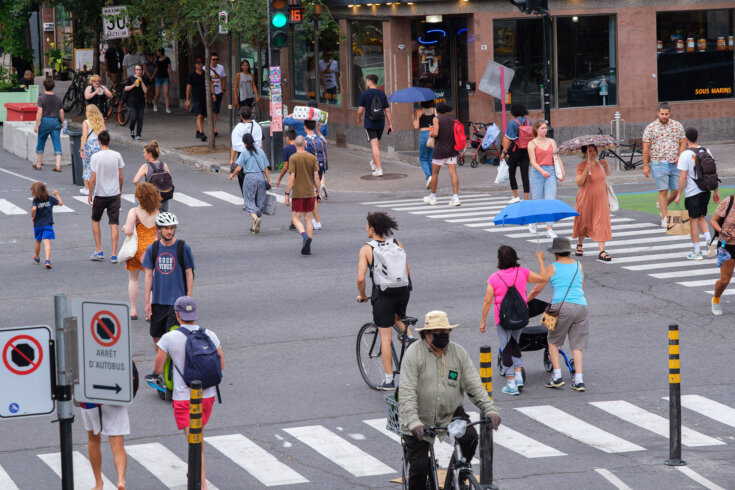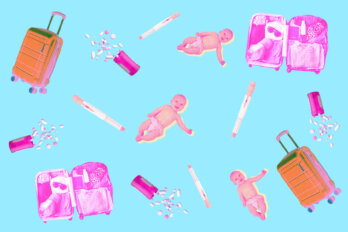In 2020, during the first pandemic summer, Montreal’s Projet Montréal administration, led by mayor Valérie Plante, closed a two-kilometre stretch of Mont-Royal Avenue to motorists for a few months. The idea was simple: get people out shopping and socializing while also respecting physical distancing guidelines.
The pilot project faced criticism from business owners concerned that removing cars would deter driving clients and complicate deliveries. But once merchants saw the street fill with milling crowds, they were convinced. The pandemic initiative became an annual event. By 2023, the avenue’s commercial vacancy rate plummeted from 14.5 percent in 2018 to 5.6 percent. A few years earlier, in 2021, the pedestrianization of Wellington Street in the Verdun borough had increased foot traffic and shoppers by 17 percent. A once-drab strip is now lined with restaurants, bars, and cafes. On Fridays, hundreds gather to dance salsa and bachata.
The pilot kept growing. As of this summer, eleven streets in total have been transformed into seasonal pedestrian-only destinations, creating almost ten kilometres of walkable car-free surfaces across several boroughs. The experiment has proven so popular that it has drawn praise, and not a little astonishment, from visiting urban planners. “In some Canadian cities I think pigs would have flown before this kind of thing would have been allowed,” said Brent Toderian, the former chief planner of Vancouver, in 2023, as reported by the Globe and Mail. “To use a technical term, it blew my mind.” Mayor Plante makes no secret of how she feels about the car-free streets, calling them “the lifeblood of Montreal’s neighbourhoods.”
Flâneur-friendly cities don’t just materialize. It took strategic planning and years of push and pull. A little over a decade ago, then Plateau-Mont-Royal mayor Luc Ferrandez set out to make his borough’s streets safer and reclaim public space. He wanted a neighbourhood people could live in and not just drive through. His first move, in 2010, was to convert a two-way ten-block stretch of Laurier Avenue to a one-way to clear more room for pedestrians, cyclists, and community activities. He didn’t stop there: he kept closing roadways that ran through parks and changing the direction of streets to divert traffic.
Resistance was fierce. Some residents complained the new measures would lengthen their work commutes. Businesses were livid about the loss of valuable parking for shoppers. At one point, dozens of shop owners in the Plateau staged a mock sale of their stores, while others closed for one hour on a Saturday afternoon to show, they said, what the street would look like if they were permanently shuttered because of policies that one merchant reportedly called “disastrous.”
Ferrandez stayed the course. More than a decade later, the borough’s transformation has been radical. More streets closed to traffic, more protected bike paths, more green curb extensions and wider sidewalks, more urban parks (including Place des Fleurs-de-Macadam, built on the site of a former garage station, that’s won multiple design awards). Neighbours mingle, children safely stroll and bike, restaurants spill out onto terrasses for that dolce far niente vibe. The sense of community fostered by walkable streets is undeniable, along with the proven benefits for the over 2,100 businesses on those car-free roads. Pedestrianizing also encouraged the city to turn those roads into open-air art galleries, with whimsical and eccentric installations that, blending form and function, serve as urban furniture. When Ferrandez resigned, in 2019, Plante praised him as “a true agent of change.”
Ferrandez, however, had a blueprint to work from. European cities have for years fostered a human-centred, communal culture of public socialization. Since Copenhagen’s Strøget area eliminated cars in 1962, its popularity as one of the world’s longest pedestrian shopping streets influenced other cities. London’s Carnaby Street went car free in 1973. One hundred or so streets in Paris are pedestrianized, while additional streets are closed to cars on Sundays and public holidays. The entire length of the famous Champs-Élysées avenue is given over to foot traffic on the first Sunday of the month. In 2021, Paris mayor Anne Hidalgo announced plans to clamp down on cars, banning them from the city centre.
Changing entrenched habits remains hard. Like most North American cities, Montreal also has car-addicted residents who have expectations of quick and unobstructed movement and easily accessible parking in densely populated urban hubs. Forward-thinking politicians must address the frustration of motorists who often overlook that pedestrians, cyclists, and transit users are taxpayers too. Car-free policies, however, promise upsides for everyone, as easing road congestion also ends up benefiting those who have no choice but to drive.
The Plante administration evidently believes it has a hot hand and is determined to play it. That includes a big commitment to cycling culture. In 2023, the city pledged $30 million to upgrade bike paths, with plans to expand Montreal’s year-round BIXI network to all boroughs by 2028. In 2023, according to Plante, usage set ridership records, with over 1.5 million cycling trips. This success demonstrates that when the right infrastructure is provided, Montrealers embrace it, building further support for pedestrian and cycling initiatives.
There is no reason other Canadian cities can’t follow suit and emulate what, according to the Toronto Star, former Toronto chief planner Jennifer Keesmaat referred to as Montreal’s “political guts.” Canadian cities like Edmonton, Vancouver, Toronto, and Hamilton are already taking baby steps. Hamilton plans to spend $60 million on 119 kilometres of new bike lanes by 2028; Toronto is getting a car-free street and has already banned cars at High Park on the weekend. But cities need bold leadership with vision. They also need citizens who, educated on the advantages of such changes, can support administrations going against the grain.
Ultimately, safer and greener public spaces do more than just reduce traffic. They help us rediscover the joy of walking and community, creating cities that put people—not cars—first.





